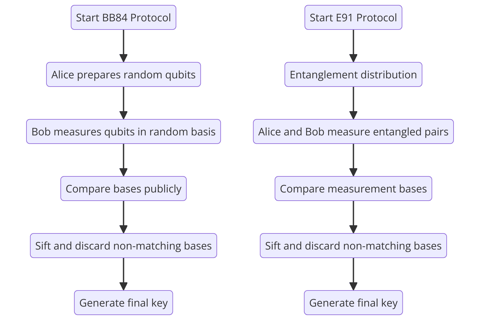Quantum Cryptography
LATEST POST
Quantum Cryptography: The Future of Secure Communication
Quantum cryptography is revolutionizing data security by leveraging the principles of quantum mechanics. As traditional cryptographic methods become vulnerable to advanced computational threats, quantum cryptography offers an innovative solution for secure communication. In this article, we explore the principles, methods, and potential applications of quantum cryptography, highlighting its significance in the future of data security.
What is Quantum Cryptography?
Understanding Quantum Mechanics
Quantum cryptography relies on the principles of quantum mechanics, specifically superposition and entanglement.
Superposition: Allows quantum bits (qubits) to exist in multiple states simultaneously.
Entanglement: Links qubits such that the state of one instantaneously influences the state of another, regardless of distance.
Quantum Key Distribution (QKD)
QKD is the cornerstone of quantum cryptography, enabling two parties to generate a shared, secret key for encrypted communication. The security of QKD is based on the detection of any eavesdropping attempts, which disturb the quantum states.
BB84 Protocol
The BB84 protocol, developed by Charles Bennett and Gilles Brassard, uses polarized photons to transmit key information.
Alice encodes each bit in a random polarization state.
Bob measures the polarization to decode the key.
A public discussion phase verifies the key and detects eavesdropping.
E91 Protocol
The E91 protocol, proposed by Artur Ekert, uses entangled particles for key distribution. Measurements of entangled particles' properties generate the key, with security ensured by the principles of entanglement and Bell's theorem.
Advantages of Quantum Cryptography
Unconditional Security
Quantum cryptography offers unconditional security based on quantum mechanics. Any eavesdropping attempt introduces detectable disturbances, ensuring the integrity of the key exchange.
Future-Proof Security
Quantum cryptography is resistant to threats from quantum computers, which can break classical cryptographic systems but cannot undermine QKD's security principles.
Challenges and Limitations
Technological Barriers
Long-distance transmission of quantum states requires advanced infrastructure, such as quantum repeaters, to maintain state integrity. Current technology limits the range and reliability of quantum communication systems.
Cost and Complexity
The deployment of quantum cryptographic systems involves significant costs and technical complexity. Specialized equipment like single-photon detectors and quantum random number generators adds to the expense.
Applications of Quantum Cryptography
Secure Communication Networks
Quantum communication networks are being developed for secure data transmission. For example, China's Micius satellite demonstrates the feasibility of long-distance QKD, paving the way for global quantum communication networks.
Financial Transactions
Quantum cryptography can secure financial transactions against sophisticated cyber attacks, ensuring the integrity and confidentiality of financial data.
Data Protection
Quantum cryptography offers robust solutions for protecting sensitive data in various fields, including healthcare, defense, and critical infrastructure.
Conclusion
Quantum cryptography represents a significant advancement in secure communication, offering unprecedented security based on quantum mechanics. Despite current challenges, its potential applications are vast and transformative. As research and development continue to advance, quantum cryptography is set to become a cornerstone of future-proof security in an increasingly digital and interconnected world.




